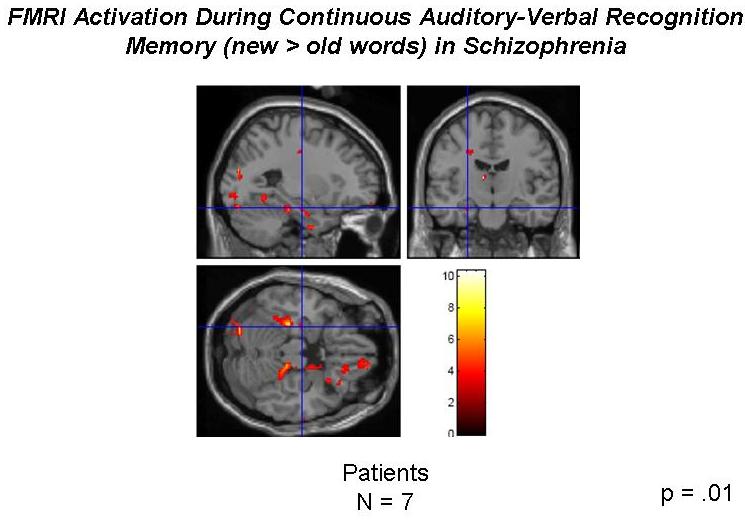Difference between revisions of "Projects:BrainActivationDuringContinuousVerbalEncodingAndRecognitionTaskInSchizophrenia"
| Line 3: | Line 3: | ||
Back to [[NA-MIC_Collaborations|NA-MIC_Collaborations]] | Back to [[NA-MIC_Collaborations|NA-MIC_Collaborations]] | ||
| − | ''' | + | '''Objectives''' |
This project employs an event-related auditory verbal episodic memory probe targeting medial temporal and DLPFC circuitry. The task uses a continuous performance format where concrete nouns are presented initially as new items. Words are then repeated after short or long intervals and the participant is required to make a new/old distinction. This design permits analysis of both encoding and recognition processes. | This project employs an event-related auditory verbal episodic memory probe targeting medial temporal and DLPFC circuitry. The task uses a continuous performance format where concrete nouns are presented initially as new items. Words are then repeated after short or long intervals and the participant is required to make a new/old distinction. This design permits analysis of both encoding and recognition processes. | ||
| Line 14: | Line 14: | ||
''Year Three Update'' | ''Year Three Update'' | ||
| + | |||
Data collection and analysis is ongoing. Updated results are expected at the end of year three. | Data collection and analysis is ongoing. Updated results are expected at the end of year three. | ||
| + | |||
| + | ''References | ||
'''Key Investigators''' | '''Key Investigators''' | ||
Revision as of 13:27, 4 September 2007
Home < Projects:BrainActivationDuringContinuousVerbalEncodingAndRecognitionTaskInSchizophreniaBrain Activation during Continuous Verbal Encoding and Recognition Task in Schizophrenia
Back to NA-MIC_Collaborations
Objectives
This project employs an event-related auditory verbal episodic memory probe targeting medial temporal and DLPFC circuitry. The task uses a continuous performance format where concrete nouns are presented initially as new items. Words are then repeated after short or long intervals and the participant is required to make a new/old distinction. This design permits analysis of both encoding and recognition processes.
Progress
To date, data have been collected on 8 patients with schizophrenia and 5 healthy controls. Preliminary analysis on a subset of this data has been completed (see figure below). Sample data is available and more data will become available in year three.
Year Three Update
Data collection and analysis is ongoing. Updated results are expected at the end of year three.
References
Key Investigators
- Dartmouth: Andrew Saykin, Robert Roth, Laura Flashman, John West, Thomas McAllister
- Harvard: Martha Shenton, Marek Kubicki
Links
